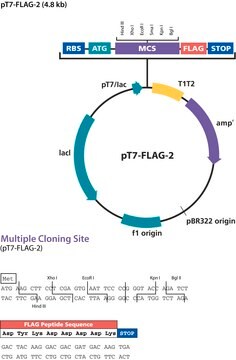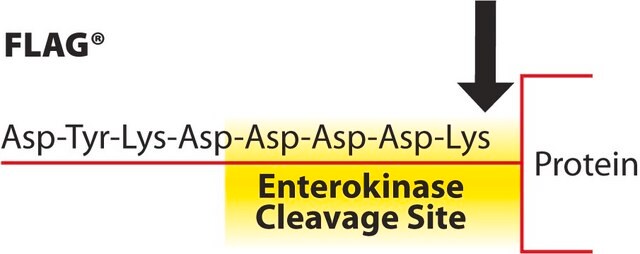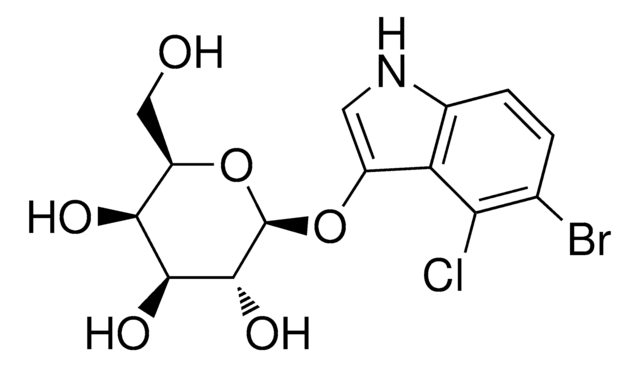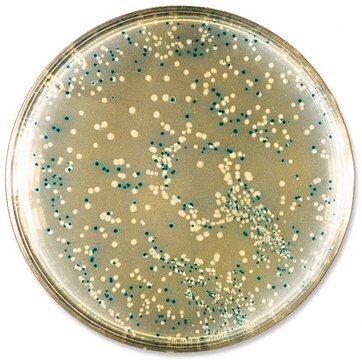PP2393
Mammalian FLAG® Tag Vector Set
plasmid vectors for molecular cloning
Sinonimo/i:
cloning vector, expression vector, molecular cloning vector, plasmid, plasmid vector, snapfast vector, vector
About This Item
Prodotti consigliati
Tag
FLAG® tagged
Stato
buffered aqueous solution
Selezione batterica
kanamycin
Selezione cellule di mammifero
puromycin
Origine di replicazione
pUC (500 copies)
Clivaggio proteico
TEV
no cleavage
Posizione del tag peptidico
C-terminal
N-terminal
Promotore
Promoter name: CMV
Promoter activity: constitutive
Promoter type: mammalian
Condizioni di spedizione
ambient
Temperatura di conservazione
−20°C
Descrizione generale
This pack enables you to compare placing FLAG epitope tags at either the N or C terminus of your gene of interest (inserted into the MCS, under transcriptional control of the CMV promoter) with, and also without a TEV (Tobacco Etch Virus) protease cleavage site. The TEV site enables removal of the FLAG tag from the protein after production. Comparing these four configurations should enable you to evaluate how best to express and detect your gene of interest from mammalian cells. We also provide many other functional tags and cleavage sites, if required.This plasmid set has been designed to be compatible with a range of cloning techniques. The multiple cloning site contains a range of standard commonly used restriction sites for cloning. Using these sites genes can be inserted using standard cloning methods with DNA ligase. Other methods such as ligase independent cloning (LIC) Gibson Assembly InFusionHD or Seamless GeneArt can also be used and because all of our plasmids are based on the same backbone the same method can be used for cloning into all of our catalogue vectors.
Multiple cloning site notes: There are a few important sites within the MCS. These include the NcoI site the XbaI site and the BsgI and BseRI sites. The NcoI site contains a start codon that is immediately downstream of both a Kozak and Shine-Dalgarno ribosomal binding site. These allow for optimal positioning of genes when the start codon is placed in this location. If this is not required and you wish to use a downstream site for gene cloning you can remove the NcoI site by cleaving the plasmid with KpnI. The XbaI site contains a stop codon. This stop codon is positioned in a specific position in relation to the BsgI and BseRI sites that are immediately downstream. When either BseRI or BsgI cleave the plasmid they produce a TA overhang from the stop codon in the XbaI site that is compatible with all of our peptide tag plasmids cut with the same sites. BseRI and BsgI sites are non-palindromic and cleave a defined number of bases away from their binding site. Whenever we clone a gene into our multiple cloning site we always position the start and stop codon in the same positions in the MCS. If the start and ends of the genes are not compatible with NcoI and XbaI we extend the sequence to the nearest external sites but keep the start and stop codons locations consistent.
Transcription Termination: These plasmids contains three alternative transcription terminators for mammalian bacterial and bacteriophage (T7) expression. This means that only the promoter needs to be changed to alter the expression system you are using. We sell multiple promoters that can be used in each of these systems. The presence of each terminator does not reduce expression in the alternative systems.
Sequenza
Risultati analitici
Note legali
I componenti del kit sono disponibili anche separatamente
- OGS3213PSF-CMV-PURO-NH2-FLAG® - N-TERMINAL FLAG® TAG MAMMALIAN PLASMID, plasmid vector for molecular cloningSDS
- OGS1124PSF-CMV-PURO-COOH-TEV-FLAG® - C-TERMINAL FLAG® TAG MAMMALIAN PLASMID, plasmid vector for molecular cloningSDS
- OGS3423PSF-CMV-PURO-COOH-FLAG® - C-TERMINAL FLAG® TAG MAMMALIAN PLASMID, plasmid vector for molecular cloningSDS
- OGS1123PSF-CMV-PURO-NH2-FLAG®-TEV - N-TERMINAL FLAG® TAG MAMMALIAN PLASMID, plasmid vector for molecular cloningSDS
Prodotti correlati
Codice della classe di stoccaggio
12 - Non Combustible Liquids
Punto d’infiammabilità (°F)
Not applicable
Punto d’infiammabilità (°C)
Not applicable
Scegli una delle versioni più recenti:
Certificati d'analisi (COA)
It looks like we've run into a problem, but you can still download Certificates of Analysis from our Documenti section.
Se ti serve aiuto, non esitare a contattarci Servizio Clienti
Possiedi già questo prodotto?
I documenti relativi ai prodotti acquistati recentemente sono disponibili nell’Archivio dei documenti.
Il team dei nostri ricercatori vanta grande esperienza in tutte le aree della ricerca quali Life Science, scienza dei materiali, sintesi chimica, cromatografia, discipline analitiche, ecc..
Contatta l'Assistenza Tecnica.








